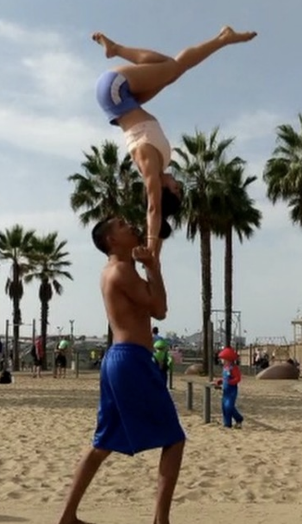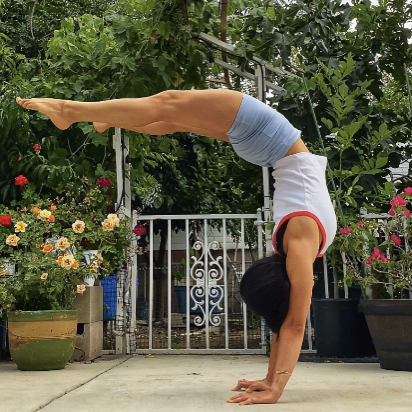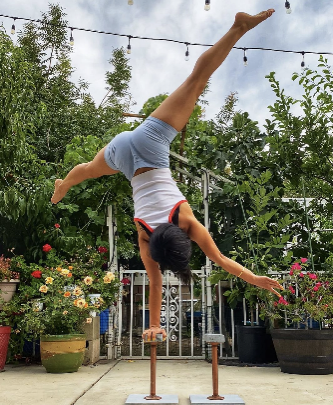What Is Handstand Acrobatics? A Beginner’s Guide to Mastering Balance and Strength
Handstand acrobatics is a physical skill that involves balance, strength, and precision. It is commonly practiced in gymnastics, circus performances, and yoga. This art form showcases the human body’s ability to balance upside down, often with a partner or in dynamic movements. In this guide, we will explore its history, techniques, and tips to help you get started.
What Is Handstand Acrobatics?
Handstand acrobatics is the practice of maintaining an inverted position using your hands. This requires a combination of core strength, flexibility, and focus. It is performed as a solo skill or with a partner, where one person (the base) supports the other (the top). Variations range from basic handstands to advanced moves like hollow backs and one-arm balances.
The History of Handstand Acrobatics
Circus Acrobatics
 Handstand acrobatics became a recognized circus skill in the early 1900s. Early performances featured standard handstands, one-arm handstands, and finger-balancing tricks. Duo and group acts gained popularity in the 1970s, coinciding with the rise of the contemporary circus. Today, these acts are staples in shows like Cirque du Soleil, often performed by aerialists, trapeze artists, and contortionists.
Handstand acrobatics became a recognized circus skill in the early 1900s. Early performances featured standard handstands, one-arm handstands, and finger-balancing tricks. Duo and group acts gained popularity in the 1970s, coinciding with the rise of the contemporary circus. Today, these acts are staples in shows like Cirque du Soleil, often performed by aerialists, trapeze artists, and contortionists.
Acrobatic Gymnastics
Hand-to-hand acrobatics in gymnastics began in the 1930s in the Soviet Union. Initially, small groups performed balancing skills. By the 1970s, the sport gained international recognition, leading to the first world championships in 1974. In the early 2000s, Acrobatic Gymnastics merged with USA Gymnastics, establishing it as a competitive sport worldwide.
Handstand Acrobatics vs. Acroyoga
| Aspect | Handstand Acrobatics | Acroyoga |
|---|---|---|
| Primary Focus | Performance and precision | Relaxation and mindfulness |
| Skill Difficulty | Advanced techniques | Beginner-friendly |
| Common Moves | Hollow back handstand, one-arm balances, pike handstand | Basic partner poses, therapeutic flying, slow transitions |
How to Get Started with Handstand Acrobatics
- Build a Strong Foundation: Develop core strength and shoulder stability. Exercises like planks, wall-assisted handstands, and push-ups are helpful.
- Practice on Safe Surfaces: Use padded mats to reduce injury risk. Avoid practicing on hard or uneven ground.
- Focus on Form: Keep your body straight with engaged shoulders and locked elbows. Proper alignment prevents strain and improves balance.
- Work with a Partner: If attempting hand-to-hand acrobatics, choose a trusted partner. Communicate clearly and practice simple poses before advancing.
Advanced Handstand Techniques
Hollow Back Handstand
 Arch your back while lowering your legs slightly. Open your shoulders to counterbalance the weight shift. This creates a graceful curve.
Arch your back while lowering your legs slightly. Open your shoulders to counterbalance the weight shift. This creates a graceful curve.
Pike Handstand
From a straight handstand, bring your feet toward your hips, creating a 90-degree angle. Keep your legs straight for clean lines.
One-Arm Straddle Handstand
 Shift your weight onto one shoulder while in a straddle position. Slowly lift one hand off the ground and hold the balance.
Shift your weight onto one shoulder while in a straddle position. Slowly lift one hand off the ground and hold the balance.
Popular Performers and Shows
Cirque du Soleil
Cirque du Soleil showcases advanced handstand acrobatics in many of its acts. Founded in 1984, it continues to set the standard for contemporary performances.
Duo Vladimir
Ukrainian acrobats known for their appearances on America’s Got Talent. Their precision and creativity inspire many aspiring performers.
Russian Acrobatic Gymnastics Team
This team dominates the competitive scene with an unmatched medal record. Their success demonstrates the artistry and discipline of acrobatic gymnastics.
Common Challenges and How to Overcome Them
- Fear of Falling: Use a wall or safety spotter when learning. Gradually build confidence as your balance improves.
- Wrist Pain: Stretch and strengthen your wrists before and after practice. Proper warm-ups reduce strain.
- Alignment Issues: Practice with a mirror or video recording to check your form. Small adjustments can make a big difference.
Ready to start your acrobatics adventure? Find a qualified instructor or program near you and begin learning today!
FAQ
- How do I start practicing handstand acrobatics safely? Begin with core-strengthening exercises and wall-assisted handstands. Progress gradually.
- What are the differences between handstand acrobatics and Acroyoga? Acroyoga focuses on relaxation and mindfulness, while acrobatics emphasizes precision and advanced skills.
- What equipment is needed to practice? Use padded mats and wrist supports to ensure safety.
- Can beginners learn advanced handstands? Yes, but only after mastering basic techniques and building strength.
- How do I find professional resources? Look for gymnastics gyms or certified acrobatics instructors in your area.